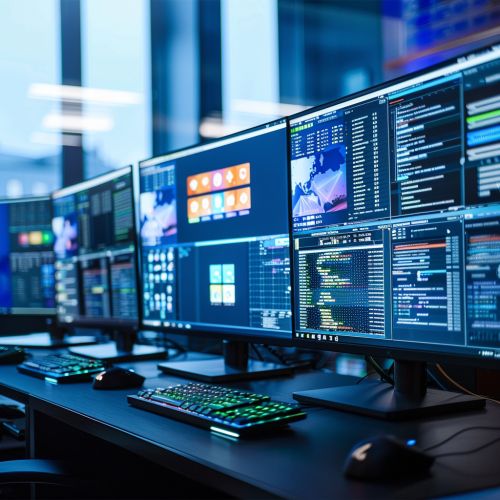Operating Systems
Introduction
An Operating System (OS) is a critical software component that manages computer hardware and software resources and provides common services for computer programs. It acts as an intermediary between users and the computer hardware. The primary goals of an operating system are to execute user programs and make solving user problems easier, as well as to make the computer system convenient to use. Additionally, the operating system manages the computer hardware in an efficient manner.
History of Operating Systems
The evolution of operating systems has been marked by several key phases:
- **Early Systems**: The earliest computers did not have operating systems. Programs were loaded using punched cards or paper tape, and the computer would execute the program directly.
- **Batch Processing Systems**: In the 1950s and 1960s, batch processing systems were developed. These systems allowed multiple jobs to be processed in a sequence without manual intervention.
- **Time-Sharing Systems**: In the 1960s and 1970s, time-sharing systems were introduced, allowing multiple users to interact with the computer simultaneously.
- **Personal Computer Operating Systems**: The advent of personal computers in the late 1970s and early 1980s led to the development of operating systems like MS-DOS and Mac OS.
- **Modern Operating Systems**: Modern operating systems, such as Windows, Linux, and macOS, offer advanced features like multitasking, graphical user interfaces, and network capabilities.
Functions of an Operating System
An operating system performs several key functions:
Process Management
The operating system is responsible for managing processes, which are instances of running programs. This includes process scheduling, creation, and termination. It ensures that processes do not interfere with each other and allocates CPU time to each process efficiently.
Memory Management
Memory management involves the allocation and deallocation of memory space to various programs. The operating system keeps track of each byte in a computer's memory and manages the allocation of memory to processes to ensure optimal performance.
File System Management
The file system management function of an operating system handles the creation, deletion, reading, and writing of files. It organizes files into directories for easy navigation and access.
Device Management
The operating system manages device communication via their respective drivers. It acts as an intermediary between the hardware and the applications that use the hardware.
Security and Access Control
Operating systems implement security measures to protect data and resources from unauthorized access. This includes user authentication, access control lists, and encryption.
User Interface
Operating systems provide user interfaces, which can be command-line based or graphical. These interfaces allow users to interact with the system and perform tasks.
Types of Operating Systems
Operating systems can be categorized based on their functionalities and applications:
Real-Time Operating Systems (RTOS)
RTOS are designed for real-time applications that require precise timing and high reliability. Examples include VxWorks and RTLinux.
Multi-User and Single-User Operating Systems
Multi-user operating systems allow multiple users to access the computer simultaneously, such as Unix. Single-user operating systems, like MS-DOS, support one user at a time.
Distributed Operating Systems
Distributed operating systems manage a group of distinct computers and make them appear to be a single computer. Examples include Amoeba and Plan 9 from Bell Labs.
Embedded Operating Systems
Embedded operating systems are designed for embedded systems, which are specialized computing devices. Examples include Embedded Linux and Windows CE.
Network Operating Systems
Network operating systems provide features for networking and communication between computers. Examples include Novell NetWare and Windows Server.
Kernel Architecture
The kernel is the core component of an operating system. It manages system resources and communication between hardware and software. There are different types of kernel architectures:
Monolithic Kernel
A monolithic kernel includes all the operating system services in one large block of code running in a single address space. Examples include Linux and Unix.
Microkernel
A microkernel architecture separates the basic functions of the kernel from higher-level services. This design aims to improve modularity and reliability. Examples include QNX and Minix.
Hybrid Kernel
Hybrid kernels combine aspects of monolithic and microkernel architectures. Examples include Windows NT and macOS.
Exokernel
Exokernels are designed to provide minimal abstractions and allow applications to have more control over hardware resources. Examples include MIT Exokernel.
Virtualization
Virtualization is the creation of virtual versions of computer resources. It allows multiple operating systems to run on a single physical machine. Types of virtualization include:
Hardware Virtualization
Hardware virtualization uses a hypervisor to create and manage virtual machines. Examples include VMware ESXi and Microsoft Hyper-V.
Operating System-Level Virtualization
Operating system-level virtualization, also known as containerization, allows multiple isolated user-space instances to run on a single kernel. Examples include Docker and LXC.
Operating System Security
Operating system security is critical for protecting data and resources. Key aspects include:
Authentication
Authentication verifies the identity of users and processes. Methods include passwords, biometrics, and multi-factor authentication.
Authorization
Authorization determines the permissions granted to users and processes. This includes access control lists and role-based access control.
Encryption
Encryption protects data by converting it into a secure format. Operating systems use encryption for file systems, network communication, and storage.
Auditing and Logging
Auditing and logging track system activity and detect security breaches. Logs provide a record of events for analysis and troubleshooting.
Future Trends in Operating Systems
The future of operating systems is shaped by emerging technologies and trends:
Cloud Computing
Cloud computing is transforming how operating systems are designed and deployed. Operating systems are evolving to support cloud-native applications and services.
Internet of Things (IoT)
The proliferation of IoT devices requires operating systems to support a wide range of hardware and communication protocols. Lightweight and secure operating systems are being developed for IoT.
Artificial Intelligence (AI)
AI is being integrated into operating systems to enhance performance, security, and user experience. AI-driven operating systems can optimize resource management and provide intelligent assistance.
Quantum Computing
Quantum computing presents new challenges and opportunities for operating systems. Research is ongoing to develop operating systems that can manage quantum hardware and applications.


